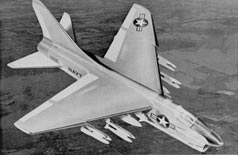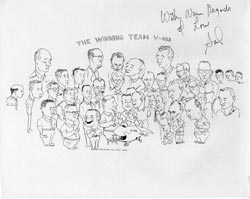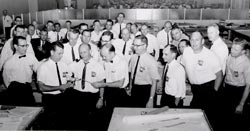|
|||||||
|
In 1962, the Navy conducted studies to determine the best route to realize its desires for a close support aircraft that could carry a very heavy weapon load and achieve a radius of action well beyond anything previously considered. Cost-effectiveness was a major consideration and modification of an existing airframe was the Navy's choice to meet all of the technical and cost requirements. When the Navy was casting about for suitable candidates, the Douglas A-4, modified to accept the TF-30 turbofan engine, already in use with the F-111, seemed to be the answer. Thus, the program was headed toward a sole-source procurement from the Douglas Aircraft Company, maker of the A-4. The designation was to be the A4D-6. No doubt, the very fine marketing apparatus of the Douglas Company played some role in this decision. The VA(L) Competition
The LTV proposal effort was spearheaded by the powerful team of Connie Lau as Program Director, Sol Love as Engineering Director, and Jesse Sanatmaria as chief designer. a competitive “blue team” effort was lead by Whit Mccormack. Lasting about six weeks, the proposal activity was probably the most intense and exciting event in the history of the company and the proposal a near-perfect product. Long hours of work and the fun nature of the A-7 proposal effort inspired a series of cartoons by proposal team engineer, Dick Atkins. Inspired by the oft asked question, what did “Sol say about that?” and the response “Sol says,” created a series of 18 cartoons depicting “interesting” management decisions.
The Winner LTV was announced as competition winner in February 1964, and negotiations began on the most unique contract in aerospace history. It was the only true fixed-price contract ever issued for a major weapon system. All incentives were negative, and the terms were so tough that LTV could have easily gone out of business trying to meet its obligations. For example, penalties were applied that required LTV to pay the Navy $50,000 per day per airplane (and there were 6 of them) for each day that Bureau of Inspection (BIS) trials were delayed. The weight target was missed by 600 pounds at a penalty to the company of $750,000. This was the only Navy requirement not met. Sol Love determined that the extra strength of the wing was worth the cost of the penalty. This turned out to be a brilliant decision because the extra strength of the wing allowed accommodation of many latter-day weapons that would have cost much more to accept if the wing had required redesign years later. The maintainability guarantee was an astonishing eleven Maintenance Man Hours Per Flight Hour in an era when the norm was 40 to 50 man hours. A $750,000 penalty was applicable in this area. LTV could have much more easily paid the penalty than meet the requirement, but that was not the Vought way. - They met the requirement! A-7: Genesis of the Navy Attack Bomber, Light (VA(L))
|

 Vought would have none of this, and through an outstanding counter-marketing effort, led by the brilliant Connie Lau, Chief of Advanced Systems at Vought, a competition was forced. It was known as VA(L), Navy Attack Bomber, Light. In late June 1963, the VA(L) Request For Proposal (RFP) was received by industry and the battle began. Four competitors responded, Douglas, Grumman, LTV, and North American.
Vought would have none of this, and through an outstanding counter-marketing effort, led by the brilliant Connie Lau, Chief of Advanced Systems at Vought, a competition was forced. It was known as VA(L), Navy Attack Bomber, Light. In late June 1963, the VA(L) Request For Proposal (RFP) was received by industry and the battle began. Four competitors responded, Douglas, Grumman, LTV, and North American.
 All who participated considered this project the highlight of their careers. Great credit is due Sol Love, their tough and charismatic leader, who inspired superior effort by everyone involved. The team was sure it would come out on top in the competition and christened itself "the winning team" at the end of the proposal effort in early August 1963.
All who participated considered this project the highlight of their careers. Great credit is due Sol Love, their tough and charismatic leader, who inspired superior effort by everyone involved. The team was sure it would come out on top in the competition and christened itself "the winning team" at the end of the proposal effort in early August 1963.
 There was not an appropriate event to cartoon at the end of the proposal effort, so Dick built a caricatured A-7 model, looking for all the world like Sol, and presented it to him as “number 19.” All had a good laugh as was the nature of the effort.
There was not an appropriate event to cartoon at the end of the proposal effort, so Dick built a caricatured A-7 model, looking for all the world like Sol, and presented it to him as “number 19.” All had a good laugh as was the nature of the effort.